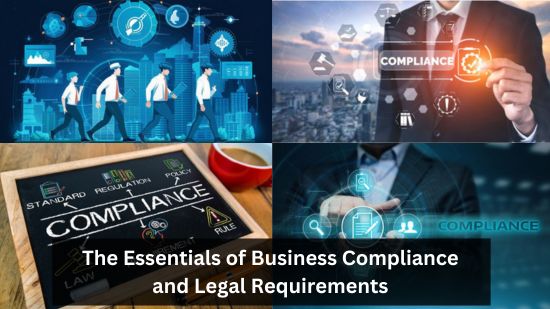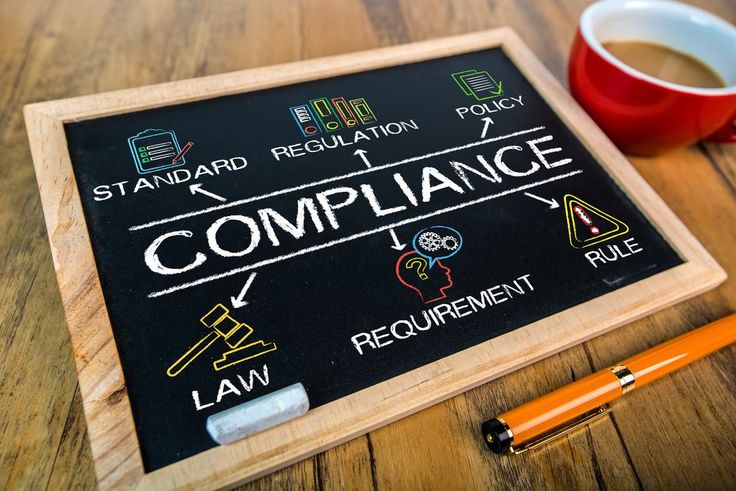
The Essentials of Business Compliance and Legal Requirements
“The Essentials of Business Compliance and Legal Requirements”
Business compliance involves a comprehensive strategy where companies align their operations with applicable laws, regulations, and industry standards. This adherence is essential not only for legal operation but also for maintaining ethical practices and operational efficiency. Effective compliance management covers multiple areas, including regulatory requirements, financial regulations, and internal operational standards. Each of these domains contributes significantly to a company’s ability to grow sustainably and protect its reputation in the marketplace.
Understanding Legal Requirements for Businesses
Legal requirements for businesses differ based on various factors, including industry specifics, geographical location, and the scale of the company. These regulations are set by local, national, and international authorities to promote fair practices, safeguard stakeholders, and uphold the integrity of the market. Compliance with these legal requirements is crucial for businesses to avoid legal issues and penalties, ensuring they operate smoothly and sustainably. Staying informed about changes in regulations and adhering to them helps companies build trust with clients, partners, and regulatory bodies.
The Importance of Compliance in Business
Compliance is not just about following the law; it’s about fostering a culture of integrity and accountability within the organization. It helps in:
- Avoiding Legal Issues: Ensures that the business operations are within the legal framework.
- Building Trust: Demonstrates a commitment to ethical practices, enhancing the company’s reputation.
- Operational Efficiency: Streamlines processes and reduces the risk of disruptions due to non-compliance.
- Financial Health: Prevents fines and penalties, safeguarding the company’s financial resources.

Credit: chetu.com
Types of Business Compliance
Regulatory Compliance
Ensures adherence to industry-specific regulations by monitoring compliance with health and safety standards, which protect employees and consumers from hazards. Additionally, it involves upholding environmental laws to minimize ecological impact and promote sustainable practices. Financial regulations are also enforced to maintain transparency, prevent fraud, and ensure economic stability within the industry.
Financial Compliance
It involves adhering to a comprehensive set of laws and regulations governing financial transactions, including proper documentation and reporting. Additionally, compliance with established accounting practices is required to ensure accuracy and transparency in financial statements. Lastly, it encompasses fulfilling tax obligations, which include timely reporting and payment of taxes according to legal requirements.
Operational Compliance
This involves overseeing daily operations to ensure that all activities adhere to established legal and regulatory requirements. It includes monitoring and reviewing internal processes to identify any areas of non-compliance and implementing corrective measures. Regular audits and updates are conducted to maintain adherence to changing regulations and industry standards.
Environmental Compliance
Adhering to laws that protect the environment involves following stringent waste management regulations to ensure proper disposal and recycling of materials. It also includes meeting emission standards to minimize the release of pollutants into the air and reduce the overall impact on climate change. By complying with these regulations, organizations contribute to preserving natural resources and promoting sustainable practices.
Legal Frameworks Governing Business Compliance
Local Laws
Regulations enacted by municipal or regional authorities establish rules and standards that businesses must follow within their specific locality. These regulations can cover a wide range of areas, including zoning laws, health and safety standards, and environmental guidelines. Compliance with these regulations is crucial for businesses to operate legally and avoid potential fines or legal issues.
National Laws
Country-wide regulations that businesses must follow encompass various critical areas, such as employment laws, which dictate how companies should handle worker rights and benefits. Taxation rules require firms to comply with the government’s guidelines on income reporting, deductions, and payments to ensure proper fiscal contribution. Corporate governance standards establish the framework for ethical business practices and transparency, mandating how companies must operate to maintain accountability to shareholders and stakeholders.
International Regulations
Global standards, like the General Data Protection Regulation (GDPR) in the European Union, are designed to ensure that businesses adhere to consistent practices across multiple countries. These regulations provide a framework for managing data protection and privacy, helping to protect individuals’ personal information from misuse. By setting these standards, global bodies aim to create a uniform level of security and compliance for companies operating internationally.

Credit: 360factors.com
Developing a Compliance Program
Risk Assessment
Identifying potential areas of non-compliance involves thoroughly reviewing processes, policies, and practices to pinpoint where they deviate from regulatory requirements or industry standards. Once these areas are identified, a comprehensive evaluation of the associated risks is conducted to understand their potential impact on the organization. This evaluation helps prioritize corrective actions and implement strategies to mitigate these risks effectively.
Policy Development
Developing clear policies and procedures involves specifying compliance requirements in a way that all stakeholders easily understand. It includes detailing expectations for adherence, outlining the steps to follow, and defining consequences for non-compliance. This clarity helps ensure consistent application and reduces the risk of misunderstandings or violations.
Training and Education
Regular training sessions are crucial for ensuring that all employees fully grasp their compliance obligations. By frequently updating and reinforcing these responsibilities, companies can help prevent potential violations and maintain adherence to regulatory standards. Additionally, consistent training fosters a culture of accountability and awareness within the organization.
Monitoring and Auditing
Implementing systems for continuous monitoring of compliance involves setting up real-time tracking tools to ensure adherence to regulations and standards. Conducting periodic audits involves scheduling regular reviews to assess and verify the effectiveness of these compliance measures. This approach allows for timely identification and rectification of any issues, ensuring ongoing adherence and improvement.
Key Compliance Areas for Businesses
Health and Safety Regulations
Ensuring a safe working environment involves strict adherence to occupational health and safety laws, which are designed to protect employees from workplace hazards. This includes implementing preventive measures such as proper training, maintaining equipment, and regularly assessing potential risks. By following these regulations, companies not only comply with legal standards but also foster a culture of safety that can enhance productivity and employee well-being.
Employment Laws
Complying with labor laws involves adhering to regulations that govern fair wages, ensuring employees are paid at least the minimum wage and overtime where applicable. It also requires observing legal standards for working hours, such as maximum limits on daily or weekly work hours and mandatory rest breaks. Additionally, employers must prevent discrimination by upholding policies that protect employees from bias based on race, gender, age, or other protected characteristics and ensure that workers’ rights are respected and upheld in the workplace.
Data Protection and Privacy
Protecting personal and sensitive data is crucial for maintaining privacy and security in today’s digital world. Compliance with data protection laws such as GDPR (General Data Protection Regulation) and CCPA (California Consumer Privacy Act) ensures that organizations handle individuals’ information responsibly and transparently. These regulations require businesses to implement stringent measures for data collection, storage, and processing and provide individuals with the right to access, correct, and delete their data.
Taxation Laws
Accurately reporting and paying taxes is crucial for maintaining compliance with tax laws and regulations. By ensuring all income and deductions are correctly reported, you minimize the risk of legal issues and potential penalties. This diligence not only protects you from audits and fines but also fosters a positive relationship with tax authorities.

Credit: thefinrate.com
Role of Compliance Officers
Duties and Responsibilities
Overseeing the compliance program involves regularly reviewing and updating policies to ensure they align with current regulations. It requires monitoring various departments to ensure adherence to these regulations and promptly addressing any deviations or issues. Additionally, this role includes preparing detailed reports on compliance status and any significant problems, which are presented to senior management to inform their decision-making.
Skills Required
Having a thorough understanding of relevant laws is essential for ensuring compliance and making informed decisions. Attention to detail is crucial in identifying nuances and avoiding errors that could have significant consequences. Strong communication skills and the ability to analyze complex information are vital for effectively conveying insights and making strategic recommendations.
Training and Certification
Professional training and certifications, such as the Certified Compliance & Ethics Professional (CCEP), significantly boost a compliance officer’s expertise. They provide a deep understanding of industry standards, legal regulations, and ethical practices, ensuring that the officer is well-equipped to handle complex compliance issues. Additionally, these credentials enhance professional credibility and demonstrate a commitment to maintaining high standards in the field.
Common Challenges in Business Compliance
Keeping Up with Changing Regulations
Laws and regulations frequently change, making it challenging for individuals and businesses to stay informed. These updates often occur at local, national, and international levels, adding to the complexity of compliance. To navigate this dynamic landscape effectively, regular review of legal resources and consultation with experts are essential.
Resource Allocation
Allocating sufficient resources, both financial and human, is crucial for effective compliance management. This involves not only budgeting for necessary tools and technologies but also investing in skilled personnel who can oversee and implement compliance strategies. Ensuring that these resources are appropriately distributed and utilized helps maintain adherence to regulations and mitigate potential risks.
Ensuring Employee Awareness
Maintaining high levels of awareness and understanding of compliance requirements among employees is crucial for ensuring that all regulations and policies are followed accurately. This involves regular training and communication to keep staff informed about any updates or changes in the compliance landscape. By fostering a culture of vigilance and accountability, organizations can minimize the risk of violations and enhance overall operational integrity.

Credit: ewsolutions.com
Technological Solutions for Compliance Management
Compliance Software
Tools designed for managing compliance requirements help organizations effectively adhere to industry standards and legal regulations. They track changes in regulations by continuously updating their databases with the latest legal and policy shifts, ensuring that users are always informed of new requirements. Additionally, these tools automate reporting processes, reducing manual effort and minimizing the risk of errors by generating accurate and timely reports.
Automated Reporting Systems
Systems that generate compliance reports automatically streamline the reporting process by eliminating the need for manual data entry. This automation not only reduces the likelihood of human errors but also ensures that reports are generated quickly and consistently. As a result, organizations can save time, reduce operational costs, and maintain higher accuracy in their compliance documentation.
Data Analytics
Leveraging data analytics to identify compliance risks and trends involves collecting and analyzing data from various sources to uncover potential areas of concern. By examining patterns and anomalies, organizations can anticipate issues before they escalate. This proactive approach allows for timely interventions, ensuring that compliance standards are maintained and regulatory requirements are met efficiently.
Consequences of Non-Compliance
Legal Penalties
Fines, sanctions, and legal actions can be significant consequences for businesses that fail to comply with regulations and laws. Fines often involve substantial monetary penalties that can impact a company’s financial health. Sanctions may include restrictions on business activities or trade, while legal actions could result in lawsuits or criminal charges against the business or its executives.
Financial Losses
Legal fees can be substantial, including costs for hiring attorneys, court fees, and other legal expenses. Fines imposed by regulatory bodies or courts can also be significant, adding financial strain. Additionally, reputational damage can lead to a loss of business, as customers may choose to take their patronage elsewhere, further impacting revenue and growth.
Reputational Damage
A negative impact on the company’s reputation can significantly damage customer trust, as consumers are likely to feel uneasy about engaging with a brand that has been publicly criticized. This erosion of trust often results in a decline in customer loyalty, reducing repeat business and making it harder to attract new clients. Additionally, the damage to the company’s public image can lead to missed business opportunities, as potential partners and clients may be deterred from associating with a company that has a tarnished reputation.

Credit: uprighthc.com
Best Practices for Ensuring Business Compliance
Regular Audits
Conducting frequent audits is crucial for maintaining ongoing compliance with regulatory standards and internal policies. These regular reviews help identify potential issues early, allowing for timely corrective actions and preventing minor problems from escalating. By staying vigilant through continuous audits, organizations can better safeguard their operations and uphold their commitment to quality and integrity.
Continuous Training
Providing ongoing training for employees ensures they remain up-to-date with the latest compliance requirements and industry best practices. This continual learning helps prevent errors and promotes adherence to regulations, reducing the risk of legal issues or fines. Regular training also fosters a culture of professionalism and competence within the organization.
Stakeholder Engagement
Engaging with stakeholders, including employees, customers, and regulators, is essential for fostering a culture of compliance within an organization. This involves open communication and collaboration to ensure that everyone understands and adheres to regulatory requirements and company policies. By actively involving these groups in compliance discussions, organizations can create a more transparent and accountable environment, which enhances overall adherence to legal and ethical standards.
Frequently Asked Questions: Business Compliance and Legal Requirements
What is business compliance?
Business compliance refers to the process of adhering to laws, regulations, and standards relevant to the business’s operations, ensuring legal and ethical conduct.
Why is compliance substantial for businesses?
Compliance is crucial as it helps businesses avoid legal issues, build trust, ensure operational efficiency, and protect financial resources.
What are the different types of business compliance?
The different types include regulatory compliance, financial compliance, operational compliance, and environmental compliance.
What are the consequences of non-compliance?
Non-compliance can lead to legal penalties, financial losses, and reputational damage, severely impacting the business.
How can businesses stay updated with changing regulations?
Businesses can stay updated by subscribing to regulatory updates, attending industry seminars, and utilizing compliance management software.
What role do compliance officers play in a business?
Compliance officers oversee the compliance program, ensure adherence to regulations, and report on compliance issues to senior management. They are essential for maintaining the program’s integrity.
Conclusion
Ensuring business compliance and meeting legal requirements is essential for any organization’s success and sustainability. By understanding the various types of compliance, developing robust compliance programs, and staying updated with legal frameworks, businesses can avoid legal issues, build trust, and operate efficiently. Embracing technological solutions and best practices will further enhance compliance efforts, ensuring long-term success and growth.






